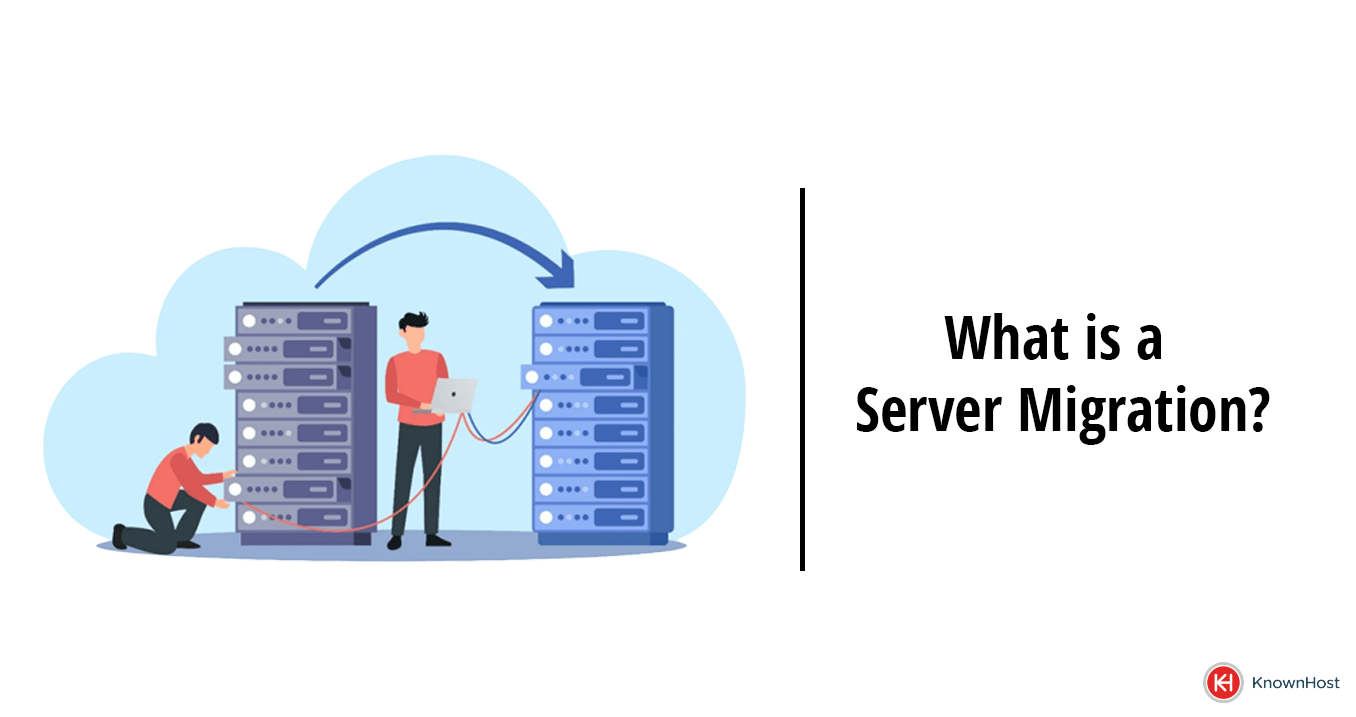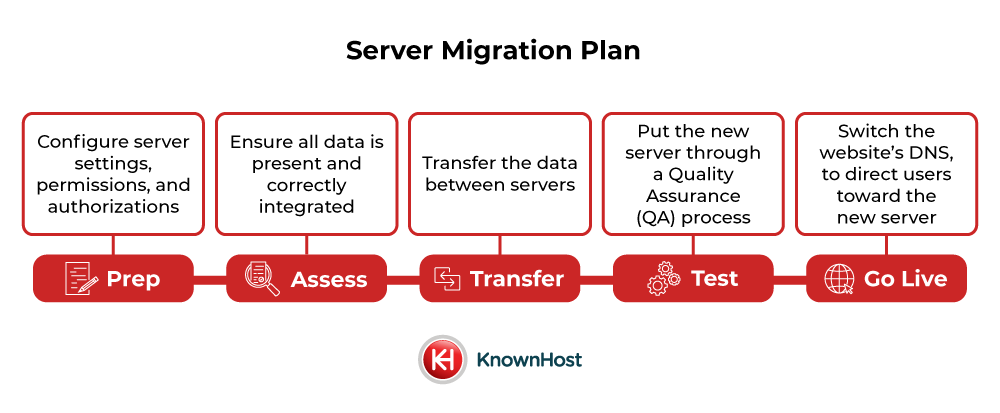What is a Server Migration?

Data is precious, and sometimes large amounts of information, for one reason or another, must be moved from one server to another – and the thought of this going wrong can be daunting.
In this article, KnownHost explains what server migration is and how to successfully plan for and perform a server migration.
What Is Server Migration?
Server migration is the process of moving large amounts of critical information from one server to another, all while making sure that the new server is properly configured to host this new information.
When it comes to web hosting services, this process revolves around setting up database software, copying over website configurations, and changing Domain Name System (DNS) parameters to help customers find the new server.
Why Migrate Servers?
One of the reasons a company may want to migrate servers is hardware limitations or faults.
Certain pieces of hardware won’t be able to perform on the same level as newer iterations, and damaged hardware may only serve to further inform a company’s decision to migrate servers.
On the opposite end of the spectrum, a company may want to simply take advantage of newer server technologies to upgrade and improve its website’s functionality. This is especially important if a server needs to have increased flexibility and scalability.
It can also be done to save money, through downgrading or consolidating servers to reduce uptime and hardware costs – or improving availability with web hosting by reducing the server load in a particular area.
How To Migrate Servers

There are five major steps in the server migration process, and each has its importance in ensuring success.
Step 1 – Prepare the New Server
The first step in the server migration process involves preparation of the new server. This includes configuring the server settings, permissions, and authorizations. Without appropriate preparation, businesses risk losing critical data in the migration.
Some considerations during this process are the server size, server permissions, server performance, and future scalability.
It’s important to consider the direction of the company. Are they looking to grow as a business? Then it’s likely that scalability and traffic flexibility must be a priority for the new server.
It’s also essential to understand if the company is making use of any new technologies or services that will need to be accounted for and incorporated into the new server’s infrastructure.
Lastly, communication is key. It’s important to inform all relevant parties that the server migration will be taking place on a particular date. This includes employees, customers, and shareholders, so that everyone can give the company a window to work on the server migration.
Step 2 – Access Data Fidelity
Data fidelity is a process that involves accounting for all data involved in the server migration and making sure it is all present and integrated properly into the new server.
Even losing a single file, such as a CSS file (containing the stylistic choices for a website) can cause dire consequences for a server, which could lead to performance issues with the website.
It’s important to understand if files in an old database are of good quality. If the quality is poor, this could lead to further issues in data corruption or the ability to migrate data in the correct format.
Likewise, it’s essential to plan how information is handled during this process, to keep in line with data protection laws. Especially if that data is sensitive. Any breach of data protection guidelines can lead to substantial fines and damaged reputations for businesses.
Step 3 – Transfer the Data
This part of the process is the largest and most time-consuming and involves transferring the data between servers. Before starting this process, it’s important to ensure that the new servers are prepared and that all files are secure.
When transferring information, all information is transported via the bandwidth between the old server and the new server. The greater bandwidth available, the faster the data transfer can take place, and the quicker this step will be.
It’s important to let employees, customers, and shareholders know when the date of the transfer is taking place to avoid miscommunication. Likewise, it’s essential to know if any high-traffic events are happening around this time to avoid transfer errors, bandwidth issues, and general performance problems.
Step 4 – QA Testing
Now the data has been transferred from one server to another, it’s advised to put the new server through a Quality Assurance (QA) process – testing the software for performance or processing issues.
A significant portion of the migration project time should be reserved for this step, as it’s essential to ensure the server is unlikely to fail regularly. Not all data transfers are 100% successful, so it’s necessary to put the server through a rigorous testing process to identify faults in the software.
The results from this testing will also inform a server maintenance team on how to best troubleshoot and fix issues should the server go down. Likewise, it can inform a company of best practices for further server migration attempts in the future.
Every action within this step must be documented so that other people working on the server at a later date can pull up this documentation and learn from its findings in the event of downtime and other issues.
Step 5 – Change DNS, Go Live
The final part of the server migration process involves switching the website’s DNS so that users are now directed toward the new server.
Switching a website’s DNS is a pretty simple process, but it’s best to make sure it’s done during off-peak hours to preserve site performance. These times include nights, weekends, and holidays.
Now that the DNS has been switched, the server is ready to go live. However, it is essential that a backup is kept in case there are problems with data on the main server.
No server control panel? No worries! Check out our guide to performing a server migration with no control panel.
How Long Does Server Migration Take?
The length of time involved in the server migration process varies and depends on factors including but not limited to, server size, data size, bandwidth speeds, site traffic, and time of day.
Server migration typically takes up to thirty minutes at the quicker end of the spectrum, to up to three hours for server migrations involving significant data transfer or those conducted at peak times.
The more data is transferred, the more bandwidth is taken up by the process – which, in turn, increases the length of time it takes for the server transfer to be complete.

Benefits of Server Migration
There are several key business benefits to server migration:
- Scalability & Flexibility: Server migration allows for upgrades in server scalability and flexibility. This is useful in allowing servers to take on a higher volume of traffic and better align with the desired functions of the server.
- Reduced Costs: Server migration can also help reduce costs, by migrating to servers with technology better suited to the business’ needs or downsizing several servers onto a single one with larger data storage.
- Improved Performance: When migrating to a server with newer or improved technology, this new server will likely improve performance. This is because a new server can be configured to reduce a heavy load in a particular part of the infrastructure.
- Security & Compliance: Upgrading to a newer server allows the server maintenance team the ability to improve data security. This means that when data is transferred, it’s more secure with a reduced risk of an information leak – boosting compliance and reducing the risk to businesses.
- Reliability: Through intense QA testing during the server migration process, the reliability of a server can be improved. This also improves the hardware reliability of the server to avoid future performance issues or drops in service.
How To Plan for a Server Migration
Server migration can be a potentially risky process for even the most experienced server maintenance team. Server failure, data loss, or data breaches can all cause headaches.
So, pre-migration planning is essential in limiting and mitigating the risks associated with server migration.
It’s important to keep an ordered server migration checklist so that the server maintenance team understands the exact risks associated with each stage and logs which tasks have and haven’t been completed.
Likewise, effective use of calendars and time blocking ensures that enough time is allocated to each stage of the migration process, to avoid mistakes associated with rushing. This helps streamline the process and reduces business disruption from the new server being non-operational.
Server migration also consumes a substantial amount of bandwidth, and plans need to be made to conduct the transfer process at off-peak times to minimize bandwidth impact. the server maintenance team must also define a contingency plan to limit downtime in case surprises happen—and they will happen.
For more essential information about planning out the server migration process, check out our handy guide.
Risks and Challenges of Server Migrations
There are several risks and challenges when it comes to server migration that businesses must be aware of to avoid disruption:
Lost or Corrupt Data
Despite best efforts, sometimes server migrations can lead to lost or corrupt data – and this is a particularly significant risk if a company handles sensitive data (such as health or financial records).
Not only does lost or corrupted data result in downtime or reduced business activity but it may even breach data protection laws, which can represent substantial fines and impacted reputations.
Firstly, server migration planning is key in mitigating this risk. Understand what data is being transferred and what the potential results of losing that data could be – and ensure the new server is configured to facilitate the quick and secure transfer and storage of this data. Likewise, proper data backups provide peace of mind that any lost or corrupt data are not lost forever.
Extended Downtime
Extended downtime during server migration can result in the potential loss of business revenue and user traffic. This is especially worrying for a new business or live service.
The best way to mitigate the risk of extended downtime is through a detailed migration planning process, as well as performing the server migration at off-peak times to avoid a lack of bandwidth slowing down the migration process.
Communication is also key to avoiding downtime. Ensure that all server maintenance staff know the five steps of a server migration and use time blocking to plan the rough time it takes to complete each stage.
Data Breach
Data breaches occur when crucial data is stolen or copied during a server migration – potentially leading to violations of data protection and confidentiality laws.T Sensitive stolen information (including that of customers) can also be used in fraudulent activities, exposing everyone to risk.
The best way to mitigate a data breach during server migration is to create a comprehensive risk assessment prior to the data transfer. Identify what data is the most sensitive and be sure to monitor all network access as the server migration takes place, being sure to flag any suspicious activity to the cybersecurity team at the earliest opportunity.
Encrypting all sensitive data can also add additional layers of file protection during transfer. Finally, evaluate all server permissions, control who has access to the server migration process, and whether their credentials are accurate.
How Can a Service Provider Help with Server Migration?
Service providers can help with every aspect of server migration to deliver a smooth and speedy data transfer with maximum uptime and security.
The level of service provided will often depend on what data is being migrated, how much, and the type of infrastructure a company wants to migrate to or from.
For smaller migration projects involving less data, automation technology can facilitate safe and secure transfers without disruption or downtime.
However, manual server migration from a dedicated team is advised when dealing with significant projects – especially those involving large data sets, confidential data, or complex server infrastructure and configurations.
KnownHost offers free server migration services to certain managed hosting clients as well as a premium server migration service to ensure a quick and easy transfer to a new server.
Our server migration services include access to our highly-skilled staff, as well as guaranteeing maximum uptime throughout the project. And a typical project is completed in around an hour.
Here’s what our satisfied server migration clients have to say:
Really really amazing support by both the sales and support team. They were attentive and easy to work with and they were there with us throughout the migration process. Highly highly recommended.
Paul Pau
01/28/2023
Our website loads amazingly fast on KnownHost – a life changing experience for our audience and for WordPress management. Furthmore, KnownHost Support Department provided awesome support migrating our website from another hosting provider. They were responsive, knowledgeable, and made sure everything went smoothly. It’s the best IT experience I’ve had in a long time – and I’m in the industry. I provided the info they needed for the migration, went to bed, woke up, and it was done flawlessly. Just wow.
Dawn Lawyer
10/06/2022
I recently migrated my WordPress website to KnownHost and was thoroughly impressed with their exceptional communication, expertise, and customer service. The migration was smooth and seamless, resulting in improved website performance. KnownHost’s team was attentive and proactive throughout the process. I highly recommend their services to anyone in need of a reliable hosting provider.
Chuck Michaels
02/12/2013
Frequently Asked Questions (FAQs)
Q: What Are Server Migration Tools?
A: Server migration tools offer features that help facilitate the server migration process while offering server configuration and additional operating system configuration settings. They can migrate personal files, applications, server settings, and additional data.
Q: How Much Does Server Migration Cost?
A: Server migration costs can vary based on the amount of data needing to be transferred, bandwidth strength, and maintenance costs. KnownHost offers free migration services to certain managed hosting clients as well as premium manual server migration services charged at $35/hour.
How to Migrate Website Hosting - KnownHost
August 15, 2023 at 11:00 am[…] Server migration can take anywhere from 30 minutes to three hours to complete and, while local servers can be transferred for free with the right knowledge, website hosting services may charge a fee for the service. […]